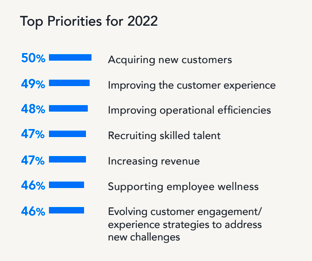Delivering consistently great customer service is critical to building brand loyalty but keeping up with growing consumer expectations can feel daunting.
After all, there are all sorts of factors impacting customer experience strategies, including workforce dynamics, ever-expanding engagement channels and exponentially more consumer interactions – which must be managed with limited budget and resources. As a result, organizations find it more difficult than ever to deliver the desired customer experience. These factors create an Engagement Capacity Gap, which impacts organizations as digital disruption increases.
To understand key customer engagement challenges and business priorities, Verint conducted a survey of more than 2,700 global business leaders and three-quarters of companies (76%) expect customer engagement challenges to increase this year.
Today, business success hinges immensely on CX, and this article offers insights on the steps organizations must take to close the gap between customer expectations and experiences.
Marketing Technology News: Rio SEO Partners With Movable Ink to Optimize Customer Experiences by Delivering Relevant, Hyperlocal Content
Top Business Priorities
Executives are recognizing the importance of the human element in an increasingly digital-first environment. While growing revenue remains important, acquiring new customers and improving customer experiences top the list of priorities, and the majority are directly related to customer and employee engagement.
 To acquire new customers and improve customer experiences, organizations must:
To acquire new customers and improve customer experiences, organizations must:
- Drive personalized, proactive connections
- Seamlessly manage a workforce of humans and bots
- Create a CX-focused culture across the organization
- Harness data to drive insights and action
- Use AI to support employee engagement and improve customer engagement
Pressures Impacting CX Strategies
Our research found that understanding and acting on consumer behaviors and building enduring customer relationships are the top two challenges for businesses today. Nearly half (47%) say obtaining a unified view of customer experience is a key difficulty.
Advances in technology, data, and analytics enable organizations to meet rising CX expectations. Still, many businesses face significant challenges with customer interaction data sitting in multiple data silos, making it difficult to orchestrate an omnichannel experience. With today’s customers now dictating their own complex, multi-channel journeys, orchestrating the workforce across all of these channels while ensuring customer engagement teams have access to relevant insights results is critical.
Meanwhile, digital working environments create even more silos, and overburdened employees struggle to find the information they need to serve customers effectively. Poor employee engagement has immediate ramifications for the customer experience, and organizations must prioritize employee wellness, engagement, and productivity to retain, enable and engage the remote workforce. As a result, organizations plan to make key investments to manage a disconnected workforce better and improve customer engagement.
Respondents in our study said their top technology-led customer engagement initiatives are supporting improved agent experience and well-being (60%), digital-first customer engagement (59%), and supporting agent guidance for expressing empathy (58%). An overwhelming majority (91%) of organizations have implemented technology and strategies to improve empathy in customer and employee interactions.
Marketing Technology News: MarTech Interview With Vibhor Kapoor, Chief Marketing Officer at AdRoll, a division of NextRoll
Investing in Happier Workers for More Engaged Customers
Organizations plan to improve self-service options for consumers and ease the burden on already overworked employees by leaning into digital channels and automation.
Intelligent automation can be employed to handle the rising number of digital-first interactions and provide a better more unique experience for customers. Simple interactions are handled promptly by self-service solutions, freeing up workers to handle more complex and emotionally charged cases on an individual basis.
Respondent’s top priority initiative is technology to support improved agent experience and well-being. At the same time, organizations say they plan to increase spending on quality and performance solutions. This will allow organizations to improve the quality of customer interactions while also enhancing employee engagement.
Organizations identified Knowledge Management (37%), Workforce Management (37%), and Chatbots and Intelligent Virtual Assistants (35%) as key areas for increased investment related to workforce engagement initiatives.
Leveraging AI to Drive Intelligent Engagement
Enabling superior customer interactions at scale requires organizations to strike the right balance between automation and human interaction. Intelligent automation addresses the increasing demand from consumers for digital-first engagement, without the need to significantly grow the workforce.
Digital-first technologies can help improve customer and employee experiences in several ways:
- Chatbots and intelligent virtual assistants (IVAs) provide instantaneous support.
- Machine learning, forecasting, natural language processing, and predictive analytics transform data into actionable insights.
- Contextual knowledge management makes chatbots and humans more effective through dynamic intelligence.
- In-channel automation enables seamless human-to-bot transition for self and assisted service.
- Customer interactions can be orchestrated across multiple channels to enable consistent, connected experiences even in cross-channel engagements.
Artificial intelligence (AI) continues to drive intelligent engagement, with 78 percent of business leaders saying that expanding AI and automation are priorities. This year, 84 percent plan to invest in technology to support the right mix of self-service and human-enabled engagement.
Marketing Technology News: Navigating The Role Of Identity Solutions For Publishers In The Programmatic Ecosystem
Doubling Down on Closing the Engagement Capacity Gap
Customer and employee expectations are at an all-time high. This has organizations investing time, money, and energy into understanding the total customer and employee experience across all engagement channels.
Organizations are leaning into customer service technology for digital-first engagement and empathy to address customer demands and expectations while reducing those demands’ adverse effects on the workforce.
While we may never completely resolve the Engagement Capacity Gap, with attention and focus, organizations can always be moving forward and making gains.











